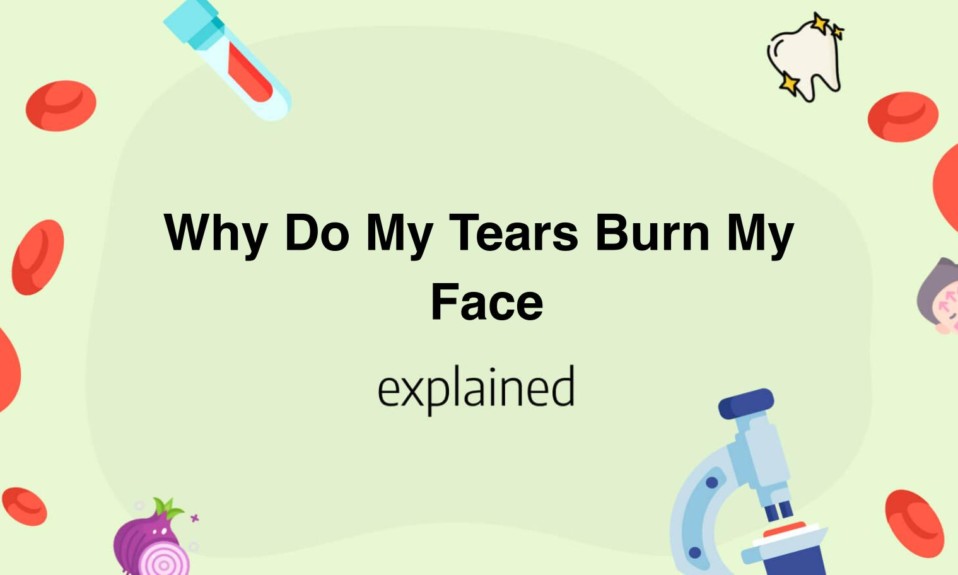If you’ve ever experienced this sensation, you may be wondering why do my tears burn my face? Tears are often associated with sadness or emotional pain, but the chemicals in your tears can also lead to physical discomfort.
The composition of tears can be affected by various factors, such as dehydration, allergies, or certain diseases.
In this article, we will explore the possible causes of why your tears may be causing a burning sensation on your face and how to alleviate the discomfort.
- Tears contain salt and enzymes that are meant to protect and nourish the eyes.
- When we cry due to emotional or physical reasons, excessive tears can be produced leading to their overflow onto the face.
- This overflow can lead to tears coming into contact with the skin around the eyes, which may be more sensitive than the eyes themselves.
- The salt and enzymes within the tears can then cause a burning or stinging sensation on the skin, especially if the skin is already irritated or damaged.
- This can be exacerbated by rubbing or wiping the eyes, which can spread the tear mixture further onto the skin.
Understanding the physiology of tear production
Tear production is a complex physiological process that occurs in the lacrimal gland, located in the upper outer corner of the eye socket.
This gland produces the tears that lubricate and protect the surface of the eye.
Tears are composed of water, salts, proteins, and lipids, and they are produced in a three-layered system.
The first layer is the mucin layer, which is the thinnest and closest to the eye surface.
This layer contains glycoproteins that help the tears adhere to the eye surface.
The second layer is the aqueous layer, which is the thickest and contains water and electrolytes that provide nourishment and hydration to the eye surface.
The third layer is the lipid layer, which is the outermost layer and is composed of oils and lipids that prevent evaporation of the tears.
The process of tear production is controlled by the autonomic nervous system, which responds to stimuli such as emotions, light, and wind.
The lacrimal gland is innervated by the parasympathetic nervous system, which stimulates tear production, and the sympathetic nervous system, which inhibits tear production.
When the eye is irritated or dry, the lacrimal gland is stimulated to produce more tears to flush away the irritant and provide moisture to the eye surface.
The tears produced by the lacrimal gland are drained from the eye into the nasal cavity through tear ducts called the lacrimal canaliculi.
If the tear ducts become blocked or narrowed, it can lead to excessive tearing or even a chronic condition called dry eye syndrome.
Understanding the physiology of tear production is important for identifying and treating conditions that affect the eyes.
Eyedrops and other medications can be used to stimulate tear production, while surgery may be necessary to correct blockages in the tear ducts.
In addition, maintaining a healthy diet rich in omega-3 fatty acids and staying well-hydrated can help support tear production and maintain healthy eyes.
Why Do My Tears Burn My Face
Tears serve a crucial role in keeping our eyes healthy and our vision clear.
They clean our eyes, washing away dirt, dust, and other particles, and provide essential nutrients to keep our eyes hydrated and healthy.
However, some individuals may experience a sensation of burning or stinging when tears touch their face.
This condition is called “reflex tearing” and is due to excessive production of tears when the eyes are irritated.
There are many reasons why our eyes can become irritated, including environmental factors like wind, smoke, and allergies, or from prolonged use of electronic devices.
When these irritants come into contact with our eyes, the body responds by producing more tears to flush them out.
These excessive tears contain a higher concentration of salt-based compounds, which can cause a burning or stinging sensation when they flow onto our cheeks.
Another possible cause of burning tears is an imbalance in the composition of our tears.
Our tears are made up of a mixture of water, oil, and mucus, and an imbalance in any of these components can lead to discomfort.
For example, individuals with dry eye syndrome, which is characterized by a low production of tears, can experience burning and stinging when their tears evaporate too quickly.
On the other hand, an overproduction of oil from the glands around the eyes can cause the tears to become too thick, leading to discomfort and irritation.
If you experience burning or stinging when your tears touch your face, there are steps you can take to alleviate the discomfort.
Avoid rubbing your eyes or using products that can further irritate them, like harsh soaps or facial scrubs.
Additionally, using lubricating eye drops or warm compresses can help soothe the eyes and reduce the sensation of burning tears.
In summary, tears are an essential part of eye health, but excessive tears due to irritation or an imbalance in tear composition can cause a burning or stinging sensation when they touch the face.
By understanding the underlying causes of this discomfort, individuals can take steps to alleviate the sensation and maintain optimal eye health.
Causes of burning tears: allergies and irritation
Burning tears are an uncomfortable and sometimes painful symptom that can be caused by allergies and irritation.
Allergies, whether seasonal or due to environmental factors, can cause the eyes to produce excess tears, leading to irritation and discomfort.
In addition, exposure to irritants such as smoke, pollution, and chemicals can also cause burning tears.
For some people, contact lenses can also cause irritation and burning.
To alleviate burning tears caused by allergies, it’s important to identify and avoid the allergen whenever possible.
Wearing sunglasses and keeping windows closed can help reduce the amount of allergens that come into contact with the eyes.
Over-the-counter antihistamine eye drops can also help alleviate symptoms.
In cases where burning tears are caused by irritants, avoiding exposure to the irritant is the best course of action.
If exposure cannot be avoided, using protective eyewear such as safety glasses or goggles can help.
Maintaining good eye hygiene can also help reduce the frequency and severity of burning tears.
Avoid rubbing or touching the eyes, as this can exacerbate symptoms.
Instead, gently washing the eyes with cool water can help soothe irritation.
If burning tears persist or worsen, it’s important to seek medical attention.
Your healthcare provider can determine the underlying cause of your symptoms and recommend appropriate treatment.
In some cases, prescription eye drops or medication may be necessary to alleviate symptoms.
In conclusion, burning tears caused by allergies and irritation can be uncomfortable and disruptive to daily life.
By identifying and avoiding allergens and irritants, practicing good eye hygiene, and seeking medical attention when necessary, individuals can alleviate symptoms and find relief.

Effects of emotional tears on the face
Emotional tears can have both physical and emotional effects on the face.
When people cry, their tear ducts release watery tears that help to flush out any irritants in the eyes, such as dust or smoke.
In addition to these reflex tears, emotional tears contain higher levels of stress hormones and protein-based compounds.
When these tears flow down the face, they can cause physical changes to the skin and face.
One of the most noticeable effects of emotional tears on the face is redness and swelling.
This happens because tears trigger blood flow to the skin around the eyes and cheeks, which can cause blood vessels to expand and dilate.
This can make the skin appear puffy and red.
Repeated crying can also lead to dehydration and dryness of the skin, which can exacerbate the appearance of fine lines and wrinkles.
Over time, frequent crying can even contribute to premature aging.
Apart from these physical effects, crying can also have a cathartic effect on the body and mind.
Crying can release pent-up emotions and stress, helping individuals to feel more relaxed and calm.
Many people also describe a sense of release or relief after crying, which can help to improve their mood and mental wellbeing.
Additionally, research has suggested that emotional tears may contain feel-good hormones and natural painkillers, which could explain why crying can provide a sense of relief.
While crying can be a natural and healthy way to process emotions, it’s important to note that excessive or unresolved crying can also be a sign of a deeper emotional issue.
If you or someone you know is experiencing prolonged periods of intense crying, it may be helpful to talk to a mental health professional.
Read also: Water Sound In Belly During Pregnancy
Connection between diet and tear production
Studies have shown that there is a connection between diet and tear production.
A diet high in omega-3 fatty acids, found in cold-water fish such as salmon, sardines, and tuna, as well as in flaxseed and walnuts, has been linked to increased tear production and reduced symptoms of dry eyes.
The reason behind this is that omega-3 fatty acids are essential components of tear film and they help to reduce inflammation in the tear glands.
Moreover, a diet rich in Vitamin A and Vitamin C, found in green leafy vegetables and citrus fruits, respectively, can help improve tear production as well.
These vitamins are essential for maintaining the health of the cornea and conjunctiva, which are important structures that produce and maintain tears.
On the other hand, a diet high in unhealthy fats, such as trans fats and saturated fats, can have negative effects on tear production and eye health.
Foods such as fried foods, processed snacks, and desserts that are high in bad fats can cause inflammation throughout the body, including the eyes.
This can lead to dry eyes and other eye problems.
Additionally, consuming too much sugar can lead to high blood sugar levels, which can damage the blood vessels that supply the eyes, leading to reduced tear production and other complications.
In essence, maintaining a healthy and balanced diet is not only important for overall health, but it is also crucial for maintaining good eye health and promoting proper tear production.
So, by incorporating foods rich in omega-3 fatty acids, Vitamin A and Vitamin C, and avoiding unhealthy fats and sugars, we can protect our eyes and help ensure that they function at their best.
You’ll also like: Why Is My Pregnant Belly Soft When I Lay Down
Treatment options for burning tears
Burning tears can be an irritating and uncomfortable problem.
Fortunately, there are several treatment options to alleviate this symptom.
One of the most common causes of burning tears is dry eye syndrome.
Lubricating eye drops, such as artificial tears, can help relieve the discomfort caused by dry eyes.
These drops work by providing a thin film of moisture to the surface of the eye, which reduces dryness and irritation.
In addition to using eye drops, it is important to avoid irritants that could exacerbate the condition.
This includes things like cigarette smoke, air pollution, and wind.
Another option for treating burning tears is to address any underlying health conditions.
For example, if burning tears are caused by an infection or inflammation of the eyelids, an antibiotic or anti-inflammatory medication may be prescribed.
Your healthcare provider can help determine the best course of action based on your specific symptoms and medical history.
If burning tears persist despite these measures, your doctor may recommend a more intensive treatment such as tear duct plugs.
These small devices are inserted into the tear ducts to block the flow of tears away from the eyes, resulting in increased moisture and less irritation.
In addition to these medical treatments, there are also lifestyle changes that can help alleviate burning tears.
This includes taking regular breaks from computer or smartphone use to rest the eyes, drinking plenty of water to stay hydrated, and getting enough sleep.
Eating a diet rich in omega-3 fatty acids can also help improve eye health.
Overall, there are several effective treatment options for burning tears.
Whether the solution is as simple as using lubricating eye drops, or more involved like tear duct plugs, it is important to seek medical guidance to determine the best course of action for your individual needs.
You’ll also like:










